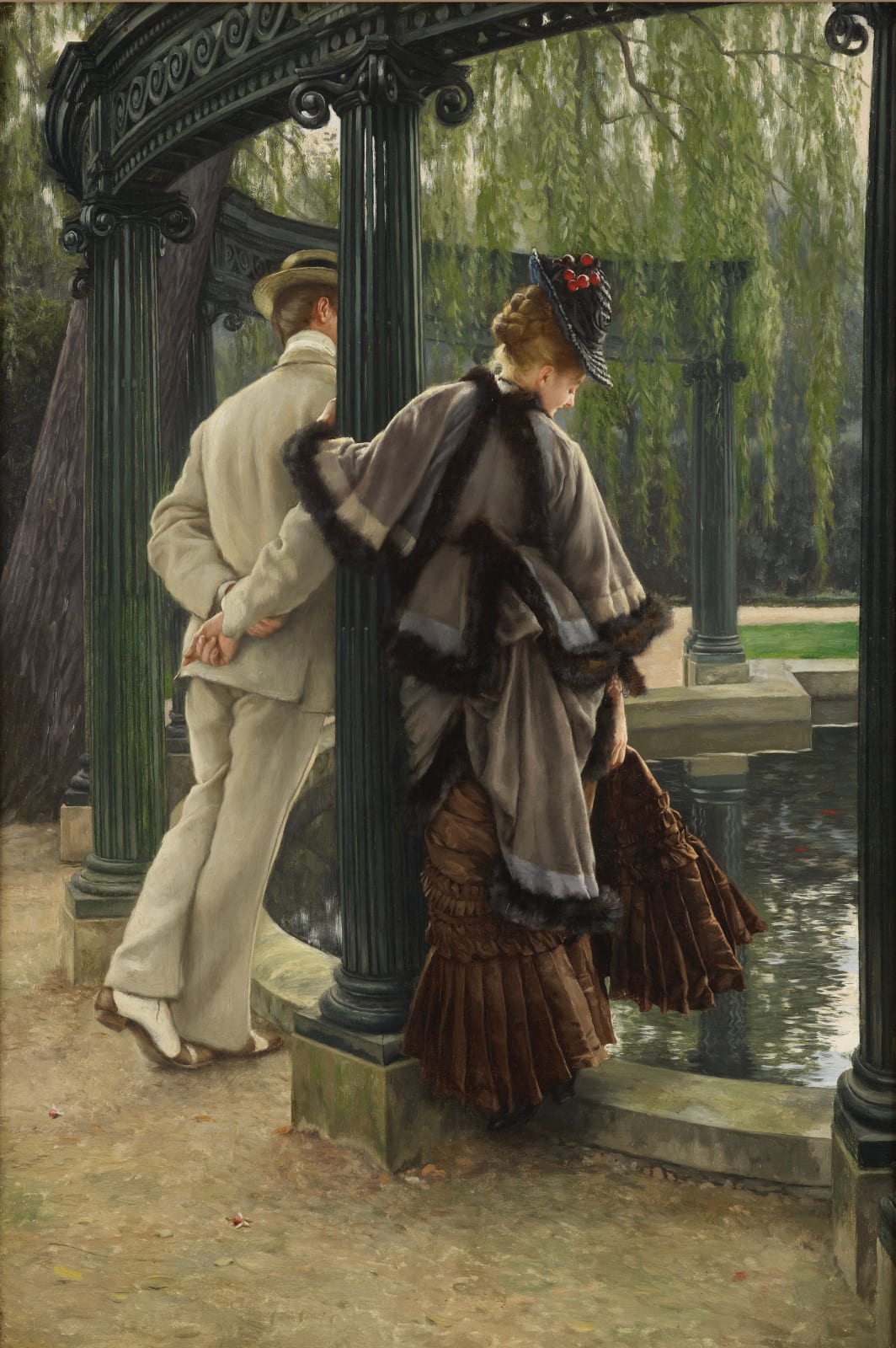-
Artworks
James Jacques Joseph Tissot 1836-1902
The Lover's Tiff, 1876Oil on canvasUnframed: 72.5 x 48 cm.; 28½ x 18¾ in.
Framed: 80 x 64 cm.; 31½ x 25 in.WB3236Copyright The Artist“A painting by Mr. Tissot will be enough for the archaeologists of the future to reconstruct our era.” Élie Roy, 1869 Within the private enclosure of his St John’s Wood...“A painting by Mr. Tissot will be enough for the archaeologists of the future to reconstruct our era.”
Élie Roy, 1869
Within the private enclosure of his St John’s Wood garden, Tissot captures a psychologically complex and visually striking moment in Victorian narrative painting. The Lover’s Tiff presents itself not merely as a snapshot of romantic discord but as a refined meditation on desire, social conventions, and the intricate choreography of human relationships. The work demonstrates Tissot’s unique ability to transform the everyday gestures of fashionable society into profound studies of emotional ambiguity. The painting shows two figures suspended in a moment of tension beside the artist’s renowned colonnade, which is itself a replica of the romantic folly from Baron Haussmann’s Parc Monceau in Paris.
The woman, turning with deliberate coyness, steps carefully onto the ornamental pool’s stone parapet, an action that suggests both retreat and allure. The exquisitely rendered brown silk dress, with intricate pleating and luxurious fur trim, serves as social armour, a facade of respectability that masks her true emotional state. The raffia hat’s red cherries echo goldfish below and scattered rose hips, creating a visual symphony while conveying Victorian symbolic meaning: innocence intertwined with sensuality.
The gentleman leans against the column with deliberate nonchalance, hands clasped behind his back. His pristine white ‘sack’ suit exemplifies casual elegance, while his John Lobb spectator shoes, originally designed for cricket enthusiasts in 1868, identify him as a gentleman of leisurely sporting tastes.
Tissot’s compositional brilliance shines through in how he transforms everyday gestures into compelling psychological theatre. The column acts as both a physical barrier and a symbolic divide, representing societal constraints that influence the lovers’ interactions. The leaning willow mirrors the gentleman’s inclined posture, suggesting that nature itself participates in this romantic drama. Light plays a vital role, flowing through the hanging branches to catch the nape of the woman’s neck, highlighting her escaped curls and creating an almost golden glow that elevates her into an object of aesthetic admiration even as she withdraws.
The apparent privacy of Tissot’s lovers, their escape from observation, would have held significant transgressive implications for contemporary viewers constrained by social courtship customs. The painting exemplifies Tissot’s skill in achieving pictorial ambiguity, setting him apart from his British contemporaries, who focused on moral clarity. Unlike traditional academic paintings that are symbolically transparent, Tissot intentionally complicates straightforward interpretation; viewers cannot easily tell if this depicts a real quarrel, an elaborate flirtation, or a ritualised romantic performance that both participants understand and enjoy.
The placement of The Lover’s Tiff within Tissot’s career is quite significant. Created during his most successful period in London, when he was earning the equivalent of a Cabinet minister’s salary, the work reflects both the confidence of professional success and the start of his personal change. Soon after completing this painting, Tissot met Kathleen Newton, the divorced Irish beauty who would become his muse, model, and companion until her tragic death from tuberculosis in 1882. Looking back, The Lover’s Tiff can be seen as Tissot’s last major commentary on romantic relationships as a social performance, before his own experience of deep passion altered his artistic perspective. The deliberate ambiguity of the garden encounter stands in stark contrast to the tender intimacy that would later define his portraits of Newton.
Through its skilful blend of technical mastery, social insight, and narrative complexity, The Lover’s Tiff attains what Charles Baudelaire regarded as the highest artistic aim: turning contemporary life into a lasting aesthetic experience.
Provenance
Sold by Tissot in 1876 for £525 to Alexander Kay as Quarrelling, commission 10% to 'Wallace' [Wallis?]
Alexander Jafferson Buist (1818-1901); John Charles Buist by 1912
Hammer Galleries, New York, March 1955
Charpentier Auctions, Paris, June 1956
Christie's, London, 26 July 1957, lot 96
With Miss Wellesley by 1967
Agnews, London, 1983
Private Collection
Exhibitions
Glasgow International Exhibition, 1901
Victoria Art Galleries in Dundee, 1912
American Federation of Arts: James Tissot: Victorian Life/Modern Love, 22 September 1999 - 2 July 2000, touring exhibition, no. 43;Oxford, Ashmolean Museum, 2017
Literature
James Tissot’s sales notebook or Carnet de ventes (whereabouts unknown; photocopy in Mantion Collection), second entry under 1876;
James Tissot’s photograph album, London. From 1871 to 1878 (private collection), unnumbered, 38th of 64 images, Connoisseur, March 1955
Etching by Tissot dated 1876 (Wentworth 18) published by Tissot in Ten Etchings by J. J. Tissot, Tissot 1876;
James Jacques Joseph Tissot: A Retrospective Exhibition, Exh. Cat., Museum of Art, Rhode Island School of Design, Providence and Art Gallery of Ontario Toronto, 1968, no, 63;
Willard E. Misfeldt, ‘James Jacques Joseph Tissot: A Bio-Critical Study’, PhD dissertation, Washington University, 1971, p. 159;
Michael Wentworth, James Tissot: Catalogue Raisonné of His Prints, Minneapolis Institute of Art, 1978, p. 90, fig. 18b;
Michael Wentworth, James Tissot, Oxford, Clarendon Press, 1984, p. 111, p. 121, pl. 97;
James Tissot, Exh. Cat., Barbican Art Gallery, London and Whitworth Art Gallery, Manchester, 1984-1985, p. 116;
James Tissot, Exh. Cat., Petit Palais, Musée de Beaux-Arts, Paris, 1984, p. 186;
Christopher Wood, Tissot: The Life and Work of Jacques Joseph Tissot, 1836-1902, London, Weidenfeld and Nicolson, 1986, pp. 76-77, fig. 74;
Willard E. Misfeldt, J. J. Prints from the Gotlieb Collection, Alexandria, VA, 1991, p. 52;
Nancy Rose Marshall and Malcolm Warner, James Tissot: Victorian Life/Modern Love, Exh. Cat., Yale Center for British Art, New Haven; Musée du Québec, Québec City, and Albright-Knox Art Gallery, Buffalo, 1999-2000, pp. 105-107, illustrated back frontispiece;
Katharine Lochnan (Ed.), Ann Saddlemyer, ‘Spirits in Space: Theatricality and the Occult in Tissot’s Life and Art’, p. 147 and p. 151, fig. 54 and Carole G. Silver, ‘Tissot’s Victorian Narratives: Allusion and Invention’, p. 132; in Seductive Surfaces: The Art of Tissot, New Haven, Yale University Press, 1999;
Melissa E. Buron with Krystyna Matyjaszkiewic, James Tissot, Fine Arts Museums of San Francisco, Delmonico Books, 2019, p. 291, illustration pl. 51;
An etching of Querelle d’amorureux was exhibited at the Royal Academy, the Paris Salon and Durand Ruel’s gallery in 1876 under the title The Garden at St John’s Wood.
Join our mailing list
Be the first to hear about our upcoming exhibitions, events and news
* denotes required fields
We will process the personal data you have supplied to communicate with you in accordance with our Privacy Policy. You can unsubscribe or change your preferences at any time by clicking the link in our emails.




